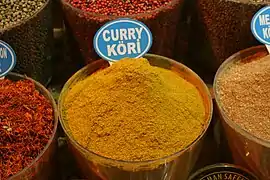Curry powder
Curry powder is a spice mix originating from the Indian subcontinent.[1][2]
 | |
| Type | Curry |
|---|---|
| Region or state | Indian subcontinent |
| Main ingredients | Spices (coriander, turmeric, cumin, fenugreek, and chili peppers) |
History
Spice mixes were found to be in use almost 4000 years ago, with key ingredients like ginger, garlic, and turmeric, during the days of Indus Valley Civilization.[3] Masalas are the spice mixes originating from the Indian subcontinent that are traditionally used for preparing Indian curries.[4]
"Curry powder", as available in certain western markets, is a commercial spice blend, comparable to the traditionally used concoction of spices known as "garam masala" in the Indian subcontinent.[5] It is conceived as a ready-made ingredient intended to replicate the flavor of kari or an Indian gravy in a dish.[6][7] It was first sold by Indian merchants to British colonial traders, resulting in the export of a derived version of Indian concoction of spices, in a ready made form for the British as an aide to making a general curry.[8] "Curry powder" as sold to British traders, was used as an ingredient in 18th century British recipe books,[9] and commercially available from the late 18th century,[10][11] with brands such as Crosse & Blackwell and Sharwood's persisting to the present.[12] British traders introduced the powder to Meiji Japan, in the mid-19th century, where it became known as Japanese curry.[13]
Etymology
The word "curry" is a western coinage or a broad reference to various Indian curries prepared with different combinations of spices in the Indian subcontinent.[14][15] The sauce like component characterized with "curry" has been derived from the Tamil word kaṟi meaning 'sauce' or 'relish for rice', and finds synonyms with other regional references to local dishes evolving over thousands of years in the Indian subcontinent, such as "jhol", "kadhi", "shorba" and "kalia".[16][17]
Nutritional information
One tablespoon (6.3 g) of curry powder contains the following nutritional information according to the USDA:[18]
- Food energy: 84 kJ (20 kcal)
- Fat: 0.883 g
- Carbohydrates: 3.52 g
- Fibers: 3.35 g
- Protein: 0.9 g
References
- "Curry | food". Encyclopedia Britannica. Retrieved 15 December 2020.
- Curried Cultures: Globalization, Food, and South Asia (1 ed.). University of California Press. 2012. doi:10.1525/j.ctt7zw4ct. ISBN 978-0-520-27011-4.
- Lawler, Andrew (29 January 2013). "The Mystery of Curry". Slate. Retrieved 10 July 2020.
- "masala". CollinsDictionary.com. Collins English Dictionary - Complete & Unabridged 11th Edition.
- llays, M (1978). "The Spices of India-II". Economic Botany. 32 (3): 238–263.
- Krystal, Becky (19 September 2020). "Indian curries offer so much flavor and variety. These 6 recipes will expand your repertoire". The Washington Post.
- Iyer, Raghavan (2016). 660 Curries. Workman Publishing Company.
- Sahni, Julie (1980). Classic Indian Cooking. New York: William Morrow and Company, Inc. pp. 39–40.
- Monks discover chicken curry recipe in 200-year-old cookbook - Telegraph, Sophie Jamieson, 13 Jan 2016
- British Library- First British advert for curry powder - 1784
- Nupur Chaudhuri; Margaret Strobel (1992). Western Women and Imperialism: Complicity and Resistance. Indiana University Press. pp. 240–. ISBN 0-253-20705-3.
- Inside the Factory (BBC2), TV review: Greg Wallace lifts the lid on how our curries are made The various ingredients of this inspired show are starting to come together in effective and flavoursome ways - Independent - Sean O'Grady - Tuesday 14 August 2018 23:00
- Itoh, Makiko (26 August 2011). "Curry — it's more 'Japanese' than you think". The Japan Times. Archived from the original on 8 January 2018. Retrieved 19 May 2019.
- "Curry". Britannica.
- Collingham, Lizzie (2006). Curry: A Tale of Cooks and Conquerors. New York: Oxford University Press. p. 115.
No Indian, however, would have referred to his or her food as a curry. The idea of a curry is, in fact, a concept that the Europeans imposed on India's food culture. Indians referred to their different dishes by specific names ... But the British lumped all these together under the heading of curry.
- "Curry". Online Etymology Dictionary.
- Iyer, Raghavan (2016). 660 Curries. Workman Publishing Company.
- "Spices, curry powder". FoodData Central. U.S. Department of Agriculture Agricultural Research Service. 1 April 2019 [April 2018]. Retrieved 10 July 2020.